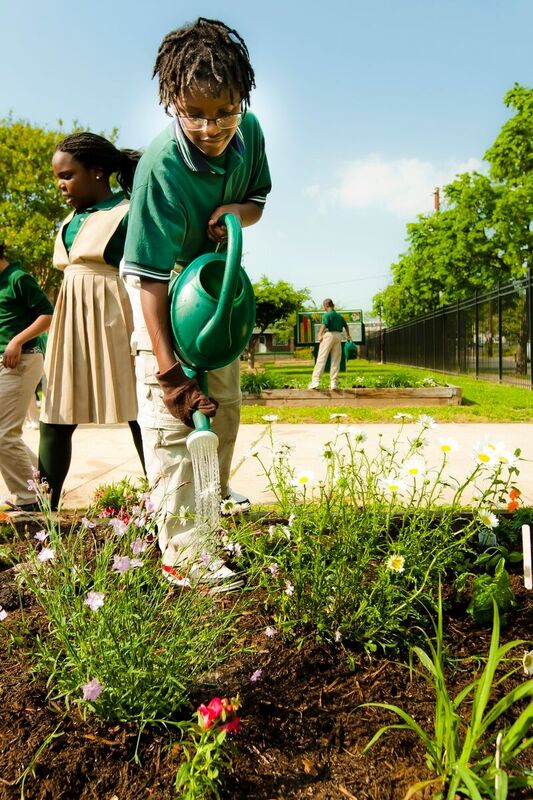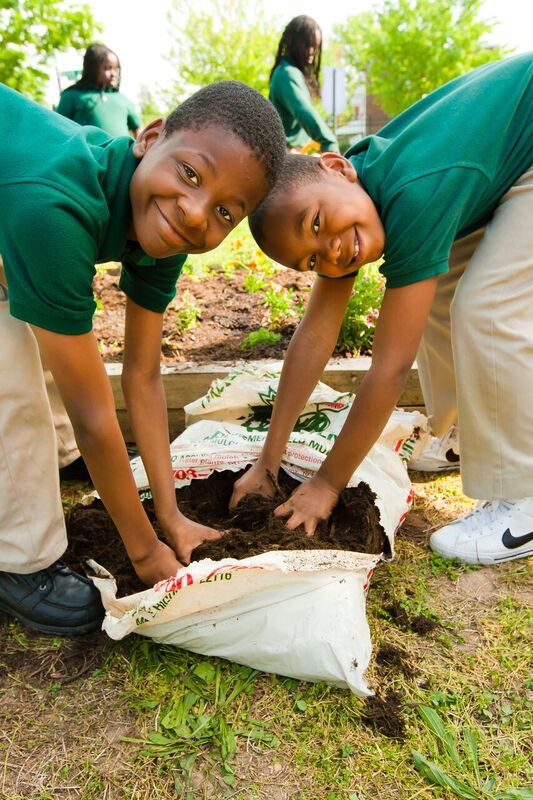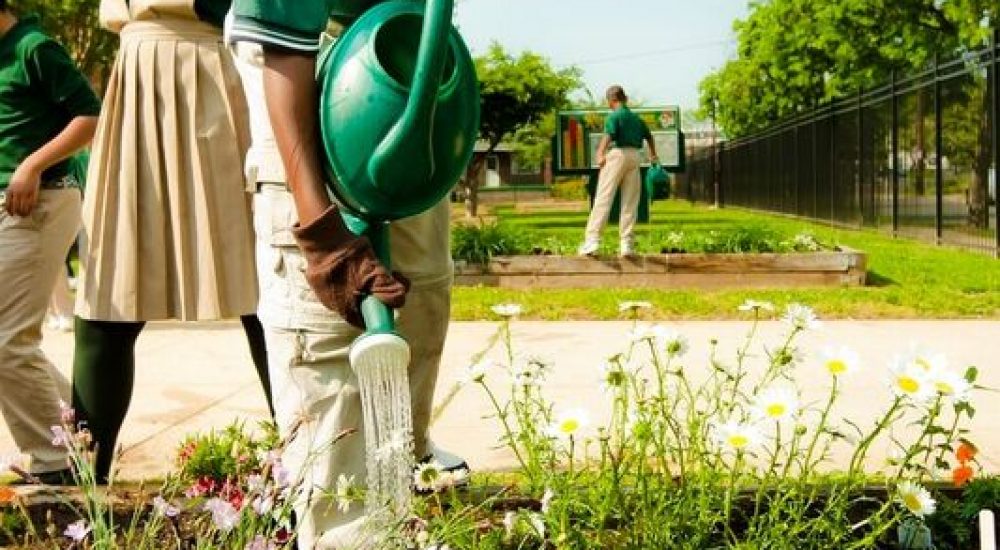Imagine if we, above all else, prioritized creating a more connected world. If we blend and integrate our passions, what innovations will we discover? What challenges would we overcome?
To celebrate National Nutrition Month, this article explores how local agriculture can help foster social connectedness.
To do this, I spoke with youth and adults representing urban and rural communities, non-profits, business and government and education agencies. Each brings a perspective that explores linkages to the built environment, education, youth engagement, workforce and inclusion.
I hope you find this exploration inspiring and enlightening. Perhaps you will identify a new partner or a new connection for your work.
Built Environment
My first two questions were for Lindsey Piant-Perez, Senior Architect and Southeast Sustainability Leader at DLR Group. Lindsey has been with DLR Group for 12 years and recently received a DLR Group Professional Development Grant to implement a garden-to-table project at Trinity Lutheran School in Orlando.
As both a parent of a young child and an accomplished architect, why do you think designing experiences that bring people together in nature is essential?
Lindsey: It always amazes me how much children naturally want to explore their environment. They like touching dirt, bugs, they look up to the sky often and truly notice the world around them. Architects focus on “what can be” about the built environment and how spaces can foster personalized learning. When we integrate indoor and outdoor environments and allow educators to bring learning concepts to life, there is a profound impact on performance.
How can the built environment create stronger families and communities?
Lindsey: A personal goal I have for my garden-to-table project is to explore how the school garden finds its way home. Will the garden influence kids in their eating habits? Will kids ask their parents to start a windowsill or backyard garden? I would love to see parents get involved with our garden; imagine if parents tended the garden with their child prior to heading home. Would that that experience reduce stress for the caregiver? Would it bring the parent and child closer?
Education
My next two questions were for Erica Walther, Farm to School Specialist with the District of Columbia Office of the State Superintendent of Education.

Tell me more about Farm to School efforts in DC and what excites you about your work.
Erica: Farm field trips are a big push for us right now and we provide grant funding to schools and community organizations to take students on trips to farms in DC, Maryland and Virginia. The DC Farm to School Network is working to create opportunities to convene champions and promote dialogue. We also actively celebrate our achievements in getting local food into school meals. We are in our fourth year of collecting data from schools on the local foods they are purchasing and serving. This allows us to track trends in local food procurement and expands our network of farmers and distributors that grow and sell locally sourced items to schools.
What role do you think connecting children with local agriculture plays in educating them about global issues like health, safety and food insecurity?
A huge one and it’s one of the reasons I love coming to work every day! Children are the future of our country; we cannot wait to help them build healthy habits and play a role in our community. I see local agriculture as a way to get children excited about eating healthy because they can connect directly with where their food comes from. They can pull a carrot from their school garden, harvest kale at a DC-based farm and meet a herd of cattle in Maryland. We see students react positively when they taste those items on-site, get to ask questions and learn about different agriculture practices.
To learn more about both farm to school as well as farm to afterschool, I turned to the Food Research and Action Center (FRAC). According to Clarissa Hayes, Child Nutrition Policy Analyst at FRAC, using local foods in summer and afterschool programming not only improves the quality of meals served but also strengthens connections to the farming community.
FRAC’s Fresh from the Farm Guide explains that locally based agriculture marketing not only helps local economies by providing jobs and keeping farm sales within communities, but keeps working agricultural land open and gives local farmers an opportunity to play a role in nutrition enrichment.
Youth Engagement
To explore the linkage to youth leadership and service-learning, I had the opportunity to speak with two student officers for Minnesota Family, Career and Community Leaders of America (FCCLA) and their advisor.

FCCLA Advisor Tammy Borman has been involved with FCCLA for 15 years. Tammy states she “highly encourages teachers to look for opportunities to engage students in service-learning based on community needs children themselves have identified.”
Mya Christensen, State President Elect has been involved for six years. She shared how being part of FCCLA has given her an opportunity to learn advocacy skills, make new friends and get out of her comfort zone by speaking in public.
When I asked Mya why she and other students should be involved in service-learning, she shared, “I think that it is important for students to be actively involved in service-learning projects because it helps them learn skills that are important to not only provide a positive impact on themselves, but also provide a positive impact on their communities.”
Mya also shared two programs of FCCLA focused on health, wellness and food insecurity. Student Body, a program that helps members develop healthy living skills and Lead2Feed, FCCLA’s national outreach program that teaches students how to help with hunger locally and globally.
I also spoke with the Minnesota FCCLA State Secretary, Johannah Nielsen for advice on involving students. Johannah shared, “Be persistent and patient because it can sometimes be a challenge to get students involved, but it all pays off greatly in the end… Every student has different interests, so planning diverse service projects that are fun and engaging is always a good idea.”
Local Government and Workforce Development
Creating opportunities to link children to local agriculture takes political champions, including local government. My next two questions went to Nancy Thellman, who works for Douglas County, Kansas as a County Commissioner.

Workforce development is a critical issue in our country. In your experience, how can connecting children with nature and local agriculture encourage them to pursue careers in farming and food production?
Nancy: Meeting farmers, especially young farmers, opens kids’ eyes to a variety of careers that most have never thought of. There is a whole world of food-related work that doesn’t necessarily require owning land or planting a single seed, including marketing, processing and distributing, culinary arts, food system planning and policy work. Food and agriculture offer a remarkable job sector that can be low-tech or high-tech, rural or urban, part-time or full-time, first career or second, third or fourth!
Do you think this linkage helps foster greater understanding of global issues like food insecurity, safety and health?
Nancy: Kids have a natural sense of what’s fair and what’s not fair. They know people shouldn’t go hungry. Kids know people would rather be well than sick. Helping them understand how access to healthy food is part of the equation for solving hunger and improving health. Wouldn’t it be great if our local farmers could be heroes in kids’ eyes?
Providing a more urban perspective, I asked Sean Madden, Transition Coordinator for St. Louis YouthBuild: Workforce development is a critical issue in our country. In your experience, how can connecting children with nature and local agriculture encourage them to pursue trade school or higher education?
Sean: Connecting children with nature and local agriculture goes a long way towards reinforcing energy conservation, a need for a greener economy and nurturing a greater understanding of global issues. Teaching young people how to be urban farmers has been one of the many focuses of two local St. Louis organizations called Gateway Greening and Earth Dance Farms in Ferguson, Missouri. Introducing more students to aspects of a green economy allows them to see a different career pipeline after high school.
Inclusion and Diversity
Ultimately, outdoor experiences and linkages to nature are only as impactful as they are inclusive. To round out the conversation with tips on inclusion, I spoke with Lori Watkins, Coordinator of Recreation for the Lakeshore Foundation in Birmingham, Alabama who regularly coordinates hunting camps for individuals with disabilities.

Acknowledging that making outdoor activities inclusive can be intimidating, Lori offered the following recommendations:
- Don’t assume that just because something is labeled “accessible” that it really is.
- Take a field trip to the area before an event to make sure it fits the needs of all individuals.
- Seek out others who have been before and ask for their feedback.
- Change your perspective. Disability doesn’t mean limited fun. Find ways to adapt so everyone benefits.
- Relax, have fun and get support from Lakeshore and the National Center on Physical Activity, Health and Disability.
Thank you to everyone who contributed to this discussion. It is my hope that these diverse perspectives help you identify additional partnerships and resources through which you can leverage local agriculture to create a more connected world.

To read extended interviews and join the conversation, visit the Alliance for a Healthier Generation’s Healthy Out-of-School Time blog.
For breakfast, I had coffee, yogurt, berries, and granola.
Author: @danielh
